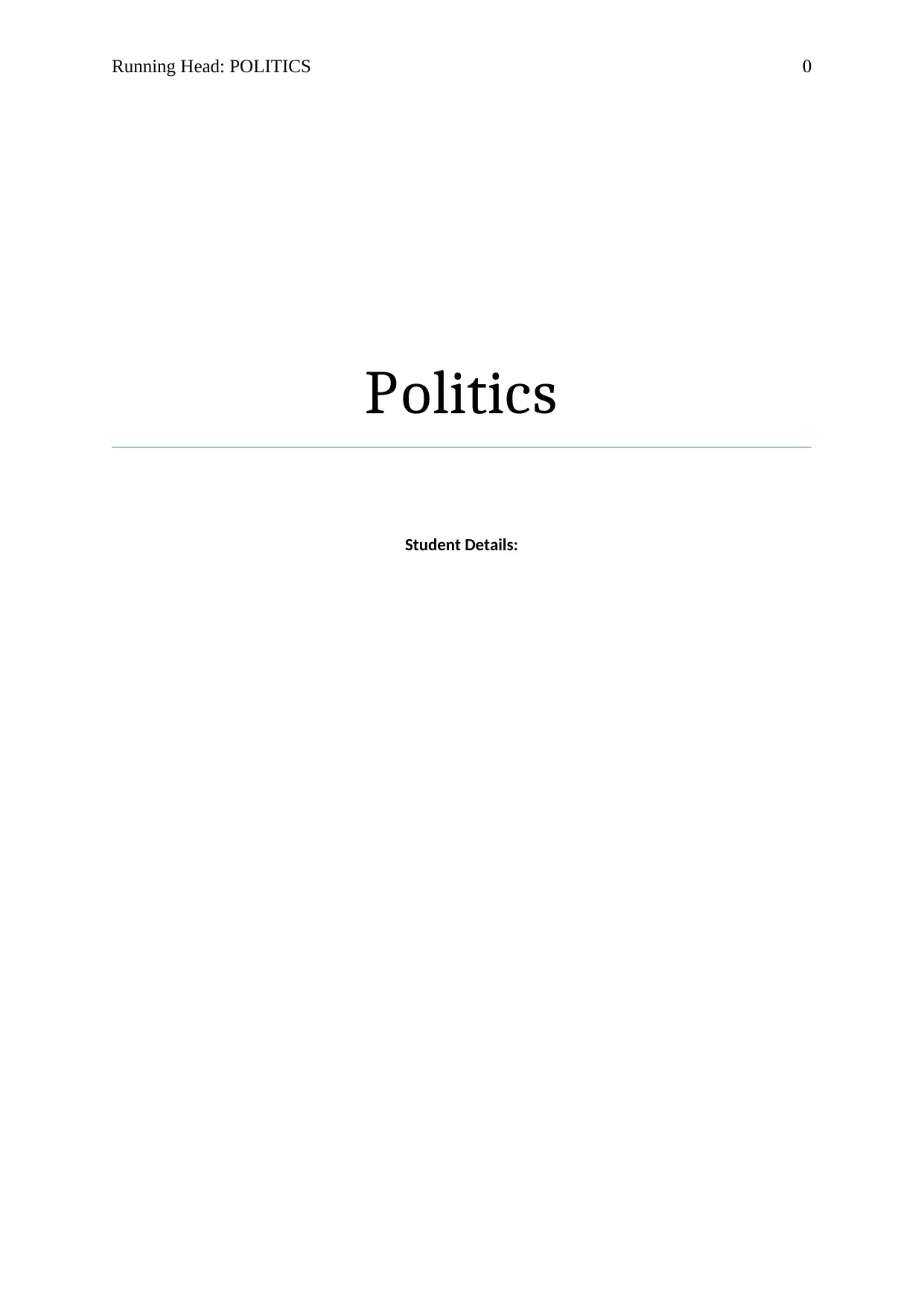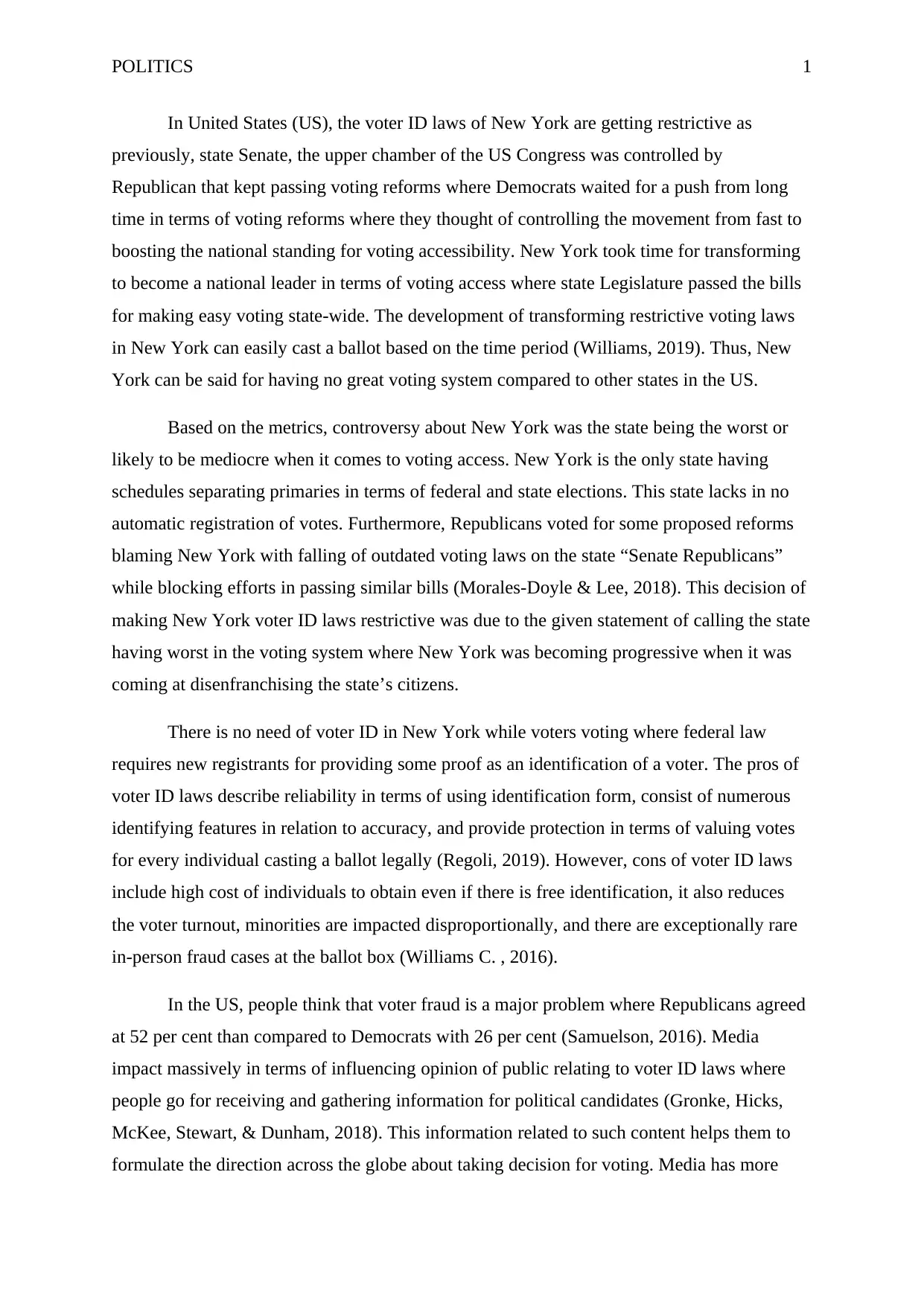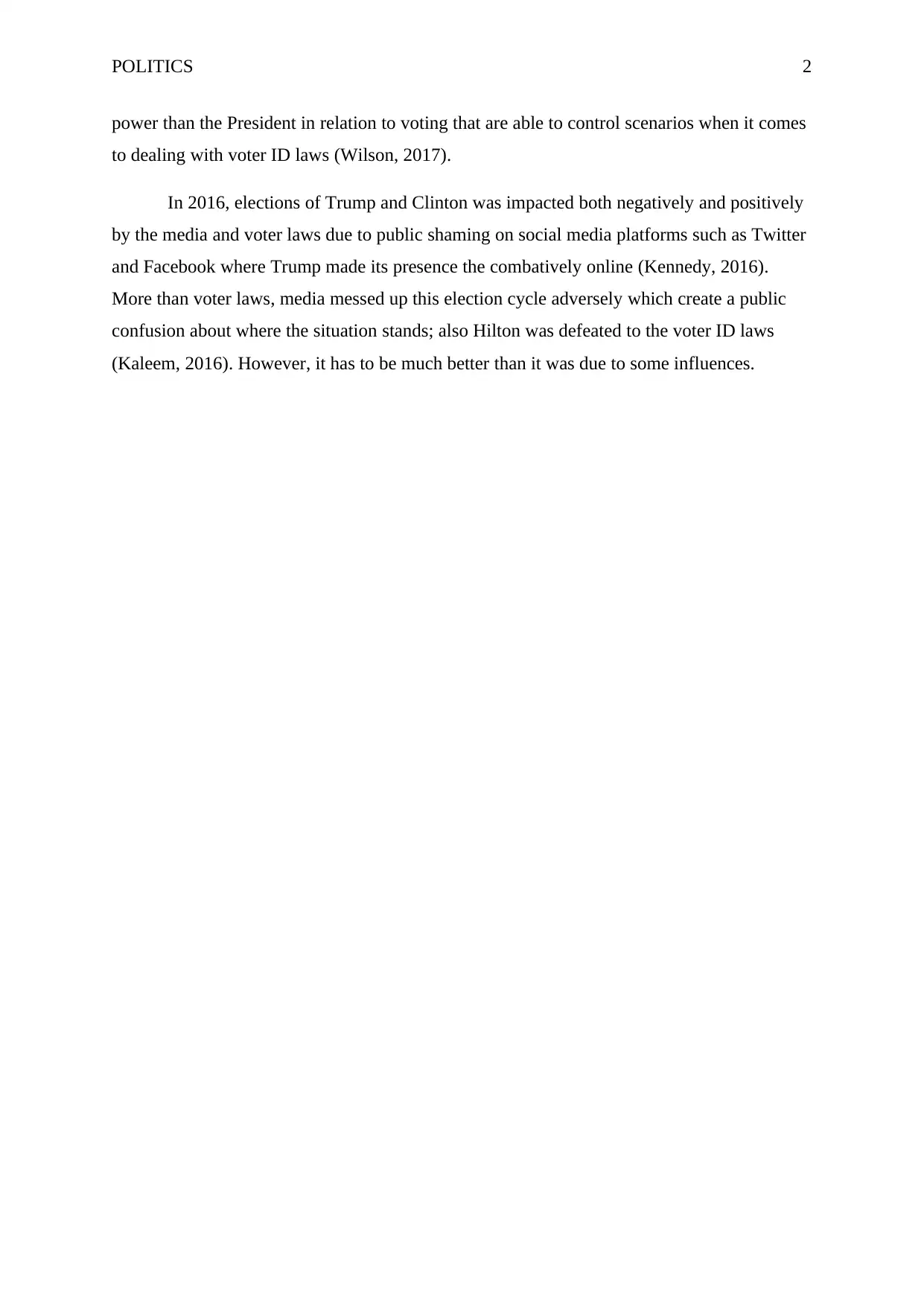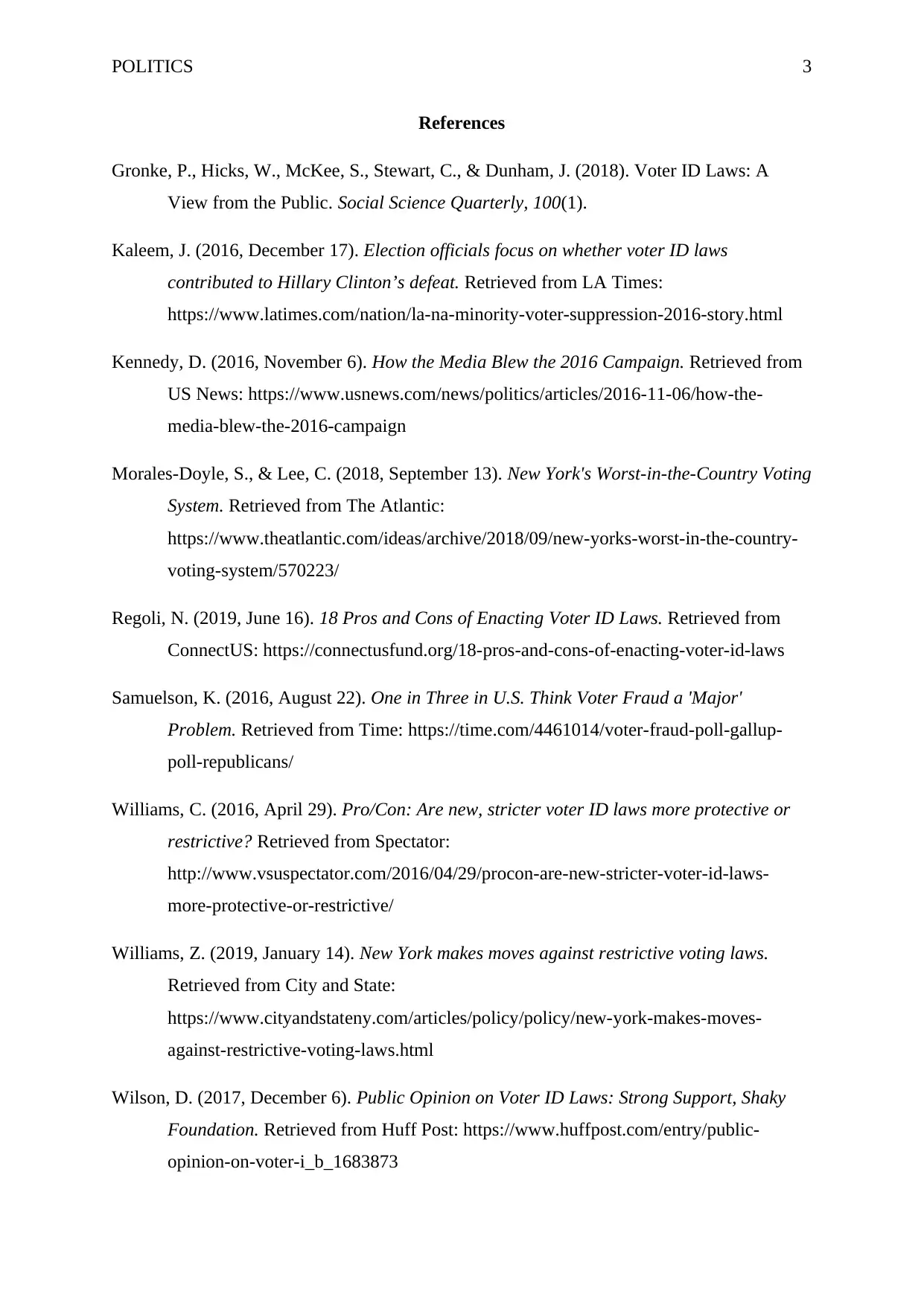Analysis of Restrictive Voter ID Laws in New York and Their Impact
VerifiedAdded on 2022/09/12
|5
|937
|21
Report
AI Summary
This report analyzes the impact of voter ID laws in New York, focusing on the state's shift towards more restrictive voting measures. It explores the political context, including the influence of Republican control in the state Senate and the resulting legislative changes. The report delves into the pros and cons of voter ID laws, discussing their effects on voter turnout, the potential for voter fraud, and the disproportionate impact on minority groups. It also examines the role of media in shaping public opinion and influencing the political discourse surrounding these laws, particularly in the context of the 2016 US presidential election. The analysis considers how media coverage and social media platforms affected the election outcomes and contributed to public confusion. The report references several academic sources to support its arguments and provide a comprehensive overview of the topic.

Running Head: POLITICS 0
Politics
Student Details:
Politics
Student Details:
Paraphrase This Document
Need a fresh take? Get an instant paraphrase of this document with our AI Paraphraser

POLITICS 1
In United States (US), the voter ID laws of New York are getting restrictive as
previously, state Senate, the upper chamber of the US Congress was controlled by
Republican that kept passing voting reforms where Democrats waited for a push from long
time in terms of voting reforms where they thought of controlling the movement from fast to
boosting the national standing for voting accessibility. New York took time for transforming
to become a national leader in terms of voting access where state Legislature passed the bills
for making easy voting state-wide. The development of transforming restrictive voting laws
in New York can easily cast a ballot based on the time period (Williams, 2019). Thus, New
York can be said for having no great voting system compared to other states in the US.
Based on the metrics, controversy about New York was the state being the worst or
likely to be mediocre when it comes to voting access. New York is the only state having
schedules separating primaries in terms of federal and state elections. This state lacks in no
automatic registration of votes. Furthermore, Republicans voted for some proposed reforms
blaming New York with falling of outdated voting laws on the state “Senate Republicans”
while blocking efforts in passing similar bills (Morales-Doyle & Lee, 2018). This decision of
making New York voter ID laws restrictive was due to the given statement of calling the state
having worst in the voting system where New York was becoming progressive when it was
coming at disenfranchising the state’s citizens.
There is no need of voter ID in New York while voters voting where federal law
requires new registrants for providing some proof as an identification of a voter. The pros of
voter ID laws describe reliability in terms of using identification form, consist of numerous
identifying features in relation to accuracy, and provide protection in terms of valuing votes
for every individual casting a ballot legally (Regoli, 2019). However, cons of voter ID laws
include high cost of individuals to obtain even if there is free identification, it also reduces
the voter turnout, minorities are impacted disproportionally, and there are exceptionally rare
in-person fraud cases at the ballot box (Williams C. , 2016).
In the US, people think that voter fraud is a major problem where Republicans agreed
at 52 per cent than compared to Democrats with 26 per cent (Samuelson, 2016). Media
impact massively in terms of influencing opinion of public relating to voter ID laws where
people go for receiving and gathering information for political candidates (Gronke, Hicks,
McKee, Stewart, & Dunham, 2018). This information related to such content helps them to
formulate the direction across the globe about taking decision for voting. Media has more
In United States (US), the voter ID laws of New York are getting restrictive as
previously, state Senate, the upper chamber of the US Congress was controlled by
Republican that kept passing voting reforms where Democrats waited for a push from long
time in terms of voting reforms where they thought of controlling the movement from fast to
boosting the national standing for voting accessibility. New York took time for transforming
to become a national leader in terms of voting access where state Legislature passed the bills
for making easy voting state-wide. The development of transforming restrictive voting laws
in New York can easily cast a ballot based on the time period (Williams, 2019). Thus, New
York can be said for having no great voting system compared to other states in the US.
Based on the metrics, controversy about New York was the state being the worst or
likely to be mediocre when it comes to voting access. New York is the only state having
schedules separating primaries in terms of federal and state elections. This state lacks in no
automatic registration of votes. Furthermore, Republicans voted for some proposed reforms
blaming New York with falling of outdated voting laws on the state “Senate Republicans”
while blocking efforts in passing similar bills (Morales-Doyle & Lee, 2018). This decision of
making New York voter ID laws restrictive was due to the given statement of calling the state
having worst in the voting system where New York was becoming progressive when it was
coming at disenfranchising the state’s citizens.
There is no need of voter ID in New York while voters voting where federal law
requires new registrants for providing some proof as an identification of a voter. The pros of
voter ID laws describe reliability in terms of using identification form, consist of numerous
identifying features in relation to accuracy, and provide protection in terms of valuing votes
for every individual casting a ballot legally (Regoli, 2019). However, cons of voter ID laws
include high cost of individuals to obtain even if there is free identification, it also reduces
the voter turnout, minorities are impacted disproportionally, and there are exceptionally rare
in-person fraud cases at the ballot box (Williams C. , 2016).
In the US, people think that voter fraud is a major problem where Republicans agreed
at 52 per cent than compared to Democrats with 26 per cent (Samuelson, 2016). Media
impact massively in terms of influencing opinion of public relating to voter ID laws where
people go for receiving and gathering information for political candidates (Gronke, Hicks,
McKee, Stewart, & Dunham, 2018). This information related to such content helps them to
formulate the direction across the globe about taking decision for voting. Media has more

POLITICS 2
power than the President in relation to voting that are able to control scenarios when it comes
to dealing with voter ID laws (Wilson, 2017).
In 2016, elections of Trump and Clinton was impacted both negatively and positively
by the media and voter laws due to public shaming on social media platforms such as Twitter
and Facebook where Trump made its presence the combatively online (Kennedy, 2016).
More than voter laws, media messed up this election cycle adversely which create a public
confusion about where the situation stands; also Hilton was defeated to the voter ID laws
(Kaleem, 2016). However, it has to be much better than it was due to some influences.
power than the President in relation to voting that are able to control scenarios when it comes
to dealing with voter ID laws (Wilson, 2017).
In 2016, elections of Trump and Clinton was impacted both negatively and positively
by the media and voter laws due to public shaming on social media platforms such as Twitter
and Facebook where Trump made its presence the combatively online (Kennedy, 2016).
More than voter laws, media messed up this election cycle adversely which create a public
confusion about where the situation stands; also Hilton was defeated to the voter ID laws
(Kaleem, 2016). However, it has to be much better than it was due to some influences.
⊘ This is a preview!⊘
Do you want full access?
Subscribe today to unlock all pages.

Trusted by 1+ million students worldwide

POLITICS 3
References
Gronke, P., Hicks, W., McKee, S., Stewart, C., & Dunham, J. (2018). Voter ID Laws: A
View from the Public. Social Science Quarterly, 100(1).
Kaleem, J. (2016, December 17). Election officials focus on whether voter ID laws
contributed to Hillary Clinton’s defeat. Retrieved from LA Times:
https://www.latimes.com/nation/la-na-minority-voter-suppression-2016-story.html
Kennedy, D. (2016, November 6). How the Media Blew the 2016 Campaign. Retrieved from
US News: https://www.usnews.com/news/politics/articles/2016-11-06/how-the-
media-blew-the-2016-campaign
Morales-Doyle, S., & Lee, C. (2018, September 13). New York's Worst-in-the-Country Voting
System. Retrieved from The Atlantic:
https://www.theatlantic.com/ideas/archive/2018/09/new-yorks-worst-in-the-country-
voting-system/570223/
Regoli, N. (2019, June 16). 18 Pros and Cons of Enacting Voter ID Laws. Retrieved from
ConnectUS: https://connectusfund.org/18-pros-and-cons-of-enacting-voter-id-laws
Samuelson, K. (2016, August 22). One in Three in U.S. Think Voter Fraud a 'Major'
Problem. Retrieved from Time: https://time.com/4461014/voter-fraud-poll-gallup-
poll-republicans/
Williams, C. (2016, April 29). Pro/Con: Are new, stricter voter ID laws more protective or
restrictive? Retrieved from Spectator:
http://www.vsuspectator.com/2016/04/29/procon-are-new-stricter-voter-id-laws-
more-protective-or-restrictive/
Williams, Z. (2019, January 14). New York makes moves against restrictive voting laws.
Retrieved from City and State:
https://www.cityandstateny.com/articles/policy/policy/new-york-makes-moves-
against-restrictive-voting-laws.html
Wilson, D. (2017, December 6). Public Opinion on Voter ID Laws: Strong Support, Shaky
Foundation. Retrieved from Huff Post: https://www.huffpost.com/entry/public-
opinion-on-voter-i_b_1683873
References
Gronke, P., Hicks, W., McKee, S., Stewart, C., & Dunham, J. (2018). Voter ID Laws: A
View from the Public. Social Science Quarterly, 100(1).
Kaleem, J. (2016, December 17). Election officials focus on whether voter ID laws
contributed to Hillary Clinton’s defeat. Retrieved from LA Times:
https://www.latimes.com/nation/la-na-minority-voter-suppression-2016-story.html
Kennedy, D. (2016, November 6). How the Media Blew the 2016 Campaign. Retrieved from
US News: https://www.usnews.com/news/politics/articles/2016-11-06/how-the-
media-blew-the-2016-campaign
Morales-Doyle, S., & Lee, C. (2018, September 13). New York's Worst-in-the-Country Voting
System. Retrieved from The Atlantic:
https://www.theatlantic.com/ideas/archive/2018/09/new-yorks-worst-in-the-country-
voting-system/570223/
Regoli, N. (2019, June 16). 18 Pros and Cons of Enacting Voter ID Laws. Retrieved from
ConnectUS: https://connectusfund.org/18-pros-and-cons-of-enacting-voter-id-laws
Samuelson, K. (2016, August 22). One in Three in U.S. Think Voter Fraud a 'Major'
Problem. Retrieved from Time: https://time.com/4461014/voter-fraud-poll-gallup-
poll-republicans/
Williams, C. (2016, April 29). Pro/Con: Are new, stricter voter ID laws more protective or
restrictive? Retrieved from Spectator:
http://www.vsuspectator.com/2016/04/29/procon-are-new-stricter-voter-id-laws-
more-protective-or-restrictive/
Williams, Z. (2019, January 14). New York makes moves against restrictive voting laws.
Retrieved from City and State:
https://www.cityandstateny.com/articles/policy/policy/new-york-makes-moves-
against-restrictive-voting-laws.html
Wilson, D. (2017, December 6). Public Opinion on Voter ID Laws: Strong Support, Shaky
Foundation. Retrieved from Huff Post: https://www.huffpost.com/entry/public-
opinion-on-voter-i_b_1683873
Paraphrase This Document
Need a fresh take? Get an instant paraphrase of this document with our AI Paraphraser

POLITICS 4
1 out of 5
Your All-in-One AI-Powered Toolkit for Academic Success.
+13062052269
info@desklib.com
Available 24*7 on WhatsApp / Email
![[object Object]](/_next/static/media/star-bottom.7253800d.svg)
Unlock your academic potential
Copyright © 2020–2025 A2Z Services. All Rights Reserved. Developed and managed by ZUCOL.

